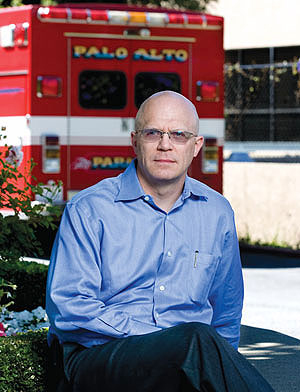July 15, 2009 - By Diane Rogers

David Spain keeps in his desk an essay about the will to survive by a patient whose injuries included a broken neck, collapsed lungs and a tear in her heart.
Every doctor carries at least one patient in his or her head—a memory of a difficult case, perhaps, or of a tragic outcome. And sometimes there’s a patient who simply touches the heart. This is the first in an occasional series about the patients they carry.
Trauma surgeons measure how hurt incoming patients are with an Injury Severity Score, or ISS. The low-risk “walking wounded” typically are rated between 0 and 9, while those with an ISS of 24 or greater are considered severely injured.
When 52-year-old Katharine Decker Johnson was flown by helicopter to Stanford’s trauma center five years ago, she was practically off the ISS scale. She’d been out for a Monday morning bike ride on the back roads of Livermore when she was struck by a 20-ton truck. “Statistically, she should never, ever have survived,” recalled David Spain, chief of trauma and critical care at Stanford Hospital & Clinics.
“We took care of her and sent her home,” he added. “And now she’s back to living her life and riding her horse.”
Johnson’s outlook on life is what makes her Spain’s most clearly remembered patient. And he is still trying to understand what turned her, against all odds, into a survivor. “I don’t like to sit around, trying to analyze the universe, so I come down on the side of random luck,” he said. But he knows there’s more to it than that. When he invited Johnson back two years ago, to talk with his colleagues about her experience, he said they were overwhelmed. “There were surgeons—grown men and women—crying in the audience.”
From treating crushed heads and legs, to ruptured spleens, Spain rarely has a typical day. He routinely goes from handling multiple injuries in the operating room to researching the clinical outcomes of injury.

Since coming to Stanford medical center in 2001, Spain also has helped to rebuild the trauma center into a national model program. As the only level-one trauma center on the Pennisula, it provides the highest level of trauma care, as determined by the American College of Surgeons: Trauma surgeons, neurosurgeons, orthopedic surgeons and anesthesiologists are available 24 hours a day and have access to sophisticated diagnostic and treatment equipment.
“Most people think their local hospital is a trauma center, but only 8 percent of U.S. hospitals are,” Spain said. “There’s a benefit to living in a community with a trauma center, and if you are hurt really bad and are brought here, you have a 20 to 25 percent greater chance of surviving.”
After her accident, Johnson’s chances were much worse. “The survival rate from CPR for blunt trauma is less than 1 percent,” Spain said. “She arrested twice at Eden Hospital, received CPR and survived, then was transferred here and arrested—and survived—again.”
Johnson had a broken neck, scapula, pelvis, sacrum, ribs, sternum and fibula, along with two broken patellas and tibia. Her liver was displaced into her chest and both lungs were collapsed. Most critically, she had suffered an aortic transection, or tear. Johnson spent a month in the intensive care unit, with surgery after surgery. Her spirit rarely flagged, and she returned home with a renewed vigor.
In his desk drawer Spain keeps an essay Johnson, a scientific illustrator, wrote in 2007, “The Life Force: Dedicated to David Spain, MD.” In it, she muses about her life journey: “What is it that keeps us breathing . . . surviving birth first of all, and then surviving the myriad of pains coming from the body, the mind and the soul throughout the passage of our time and space that we name our life?”
The questions are mostly unresolved, but there are indications of an inner resolve. “Nothing and no one is going to take me down,” she writes. “Just give me all you have . . . I will win; no other option.”
And the conclusion is bright with promise: “I look ahead with eyes wide with wonder, I relax, I let go, I live.”
About Stanford Medicine
Stanford Medicine is an integrated academic health system comprising the Stanford School of Medicine and adult and pediatric health care delivery systems. Together, they harness the full potential of biomedicine through collaborative research, education and clinical care for patients. For more information, please visit med.stanford.edu.